| NEW CABLE CONVERTER FOR SEISMOMAGNETOMETRIC DETECTION.
MAKSIMOV Andrey Mikhailovich TREATING “BLUE TOOTH”.
The rapidly growing sphere of cellular telephony has already given rise to more than one new channel for information leakage. Among them is the popular Bluetooth communication protocol, which is equipped with almost all “advanced” models of cell phones today, not to mention smartphones and pocket computers (the so-called “palmtops”). Communication devices using the Bluetooth data transfer protocol, despite all the efforts of communications and cryptography specialists, are becoming easy prey today even for novice hackers. Corresponding methods for penetrating a telephone, hacking programs and even the necessary equipment (special antennas) have been developed and are available, allowing an intruder to “see a specific telephone handset at a distance of up to a kilometer. Such attacks are fraught with a lot of problems for the owner of a specific mobile phone. Among them are copying the phone and address book, SMS messages, photos and any other data from the handset, using the phone services, i.e. the Internet, WAP and GPRS, gaining access to the phone's AT commands, namely, the ability to send messages (in any quantity) and call any numbers. The most offensive thing is that all this happens without any telltale signs and, of course, without the knowledge of the phone user. A mobile communication device can also be significantly damaged, in particular due to infection with viruses that can completely disable Bluetooth, the built-in file manager, the phone book, block and damage the operating system, etc. Most phone owners do not even suspect the existence of such a threat and do not try to protect themselves, at least by disabling Bluetooth on their phone (as recommended by cell phone manufacturers). Unfortunately, even forced switching of a Bluetooth device to “invisible” mode cannot be a complete guarantee of security today, since there are corresponding access methods. The engineering and manufacturing enterprise NERA-S, which has been dealing with cellular telephony security issues for several years, has developed a miniature intelligent device that allows you to reliably protect your phone from unauthorized use of the Bluetooth channel. The device is placed in close proximity to the telephone receiver and records any attempts at external attacks that threaten your phone. The protection device will notify the owner of this with three sound signals. After identifying the attack, a radio interference generator is turned on, which completely blocks the specified communication channel. The developers of NERA-S managed to make the Bluetooth blocker so miniature that it fits into the acoustic safes Ladya and Kokoon, which have already become familiar to many users of cellular phones. The new Ladya-VT and Kokon-VT devices now provide protection for the handset not only from unauthorized activation of the cell phone microphone, but also guarantee the prevention of any penetration into your cell phone via the Bluetooth channel. Engineering and production enterprise «NERA-S» |
